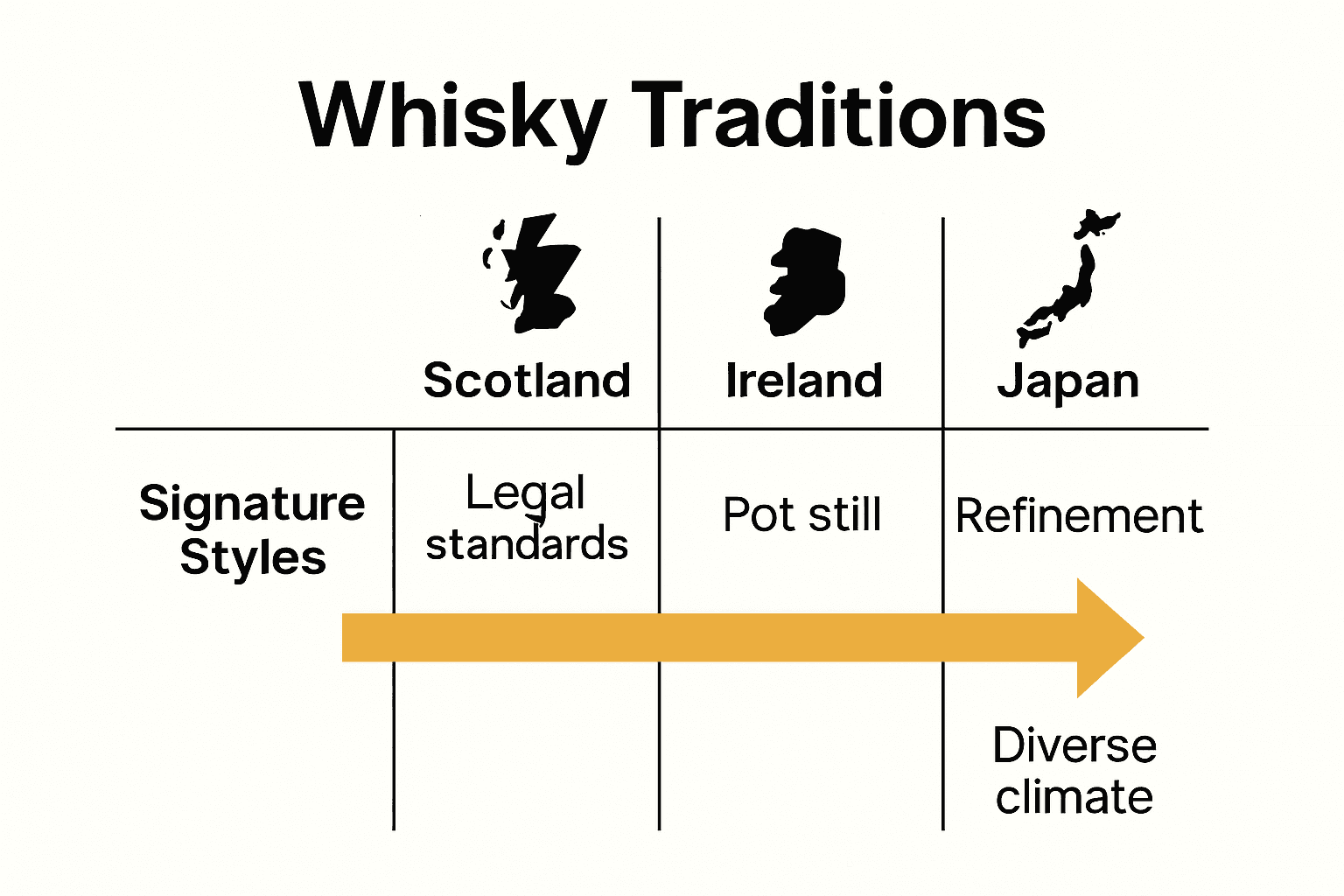Over two billion bottles of whisky are enjoyed worldwide each year, reflecting a history that reaches back nearly a thousand years. This beloved spirit began as the “water of life” in ancient monasteries but has since grown into a global symbol of culture and tradition. Exploring whisky’s heritage reveals a remarkable journey of craftsmanship, innovation, and the unique character each region has brought to this timeless drink.
Table of Contents
- Defining Whisky Heritage And Its Roots
- Major Whisky Traditions Across The World
- Influence Of History On Regional Styles
- Cultural Rituals And Symbolism In Whisky
- Collecting, Preserving, And Celebrating Heritage
Key Takeaways
| Point | Details |
|---|---|
| Whisky Origins | Whisky, derived from the Gaelic ‘uisge beatha’, traces its roots back to monastic distillation practices in Ireland and Scotland around 1100 CE. |
| Cultural Significance | Whisky embodies deep cultural connections and rituals that transcend mere consumption, acting as a symbol of social bonding and shared heritage. |
| Regional Innovations | Each whisky-producing region has developed unique characteristics and production methods, reflecting local traditions and ingredients. |
| Preservation of Heritage | The whisky industry emphasizes preserving artisanal craftsmanship and historical techniques while adopting modern scientific advancements for quality enhancement. |
Defining Whisky Heritage And Its Roots
Whisky, a beloved spirit with roots stretching back centuries, represents far more than just an alcoholic beverage. According to ebsco, the term originates from the Gaelic ‘uisge beatha,’ meaning water of life, with its origins tracing back to around 1100 CE. During this period, monks in Ireland and Scotland ingeniously adapted distillation techniques to transform humble barley into a sophisticated alcoholic drink.
The heritage of whisky is deeply intertwined with cultural traditions and monastic practices. Wikipedia reveals that these early monks initially developed distillation processes primarily for medicinal purposes, viewing the resulting liquid as a potential healing elixir. This medicinal origin highlights whisky’s transformation from a therapeutic substance to a globally celebrated spirit.
Beyond its historical beginnings, whisky heritage represents a complex narrative of craftsmanship, regional innovation, and cultural identity. Each whisky-producing region developed unique methodologies reflecting local ingredients, climate, and traditions. From the peaty landscapes of Scotland to the precise techniques of Japanese distilleries, whisky embodies a rich tapestry of human creativity and technological adaptation. A Brief History Of Whisky provides deeper insights into how different cultures have shaped this remarkable drink over generations.
Today, whisky continues to evolve, bridging ancient traditions with modern innovation. What began as a monastic experiment has transformed into a global phenomenon, with each bottle carrying centuries of knowledge, passion, and cultural significance. The heritage of whisky is not just about the liquid in the glass, but the stories, techniques, and human connections that have been carefully distilled through time.
Major Whisky Traditions Across The World
Whisky traditions represent a fascinating global tapestry of cultural expression, with each region developing distinctive approaches to spirit production. According to PMC, spirits like whisky and baijiu exemplify the unique grain-based beverages prominent in Western and Eastern cultures, each boasting remarkable production methods and nuanced flavor profiles.
In Scotland, Scotch whisky stands as a pinnacle of tradition, characterized by strict legal definitions and regional variations. Scotch Whisky: Complete Guide to Its Legal Definition highlights the meticulous regulations surrounding this iconic spirit. Scottish whisky regions like Islay, Speyside, and Highland each contribute distinctive characteristics, from smoky and peated expressions to more delicate, floral interpretations.
Japanese whisky represents another remarkable tradition, blending meticulous craftsmanship with profound respect for technique. Drawing inspiration from Scottish methods while developing unique approaches, Japanese distilleries have gained international acclaim for their precision and elegant flavor profiles. The Japanese Whisky Explained reveals how this tradition emerged from careful study and innovative adaptation of Western distillation practices.
Emerging whisky traditions continue to expand the global landscape. Australian distilleries, for instance, are carving out a unique identity, experimenting with local ingredients and innovative techniques. These new world whisky traditions demonstrate that while the core principles of whisky production remain consistent, there’s always room for regional creativity and exploration. The beauty of whisky lies not just in its taste, but in its ability to tell a story of place, culture, and human ingenuity.

Here’s a comparison of notable whisky traditions across major regions:

| Region | Key Characteristics | Signature Styles |
|---|---|---|
| Scotland | Strict legal standards Peated malt variety Distinct regions |
Islay Peated Speyside Floral Highland Robust |
| Ireland | Triple distillation Smoother finish Monastic roots |
Pot Still Blended Irish |
| Japan | Inspired by Scottish methods Precision & craftsmanship Subtle flavour focus |
Single Malt Japanese Grain Whisky |
| Australia | Innovative techniques Local grains Emerging identity |
Single Malt Australian Small Batch |
Influence Of History On Regional Styles
Historical contexts have profoundly shaped the distinctive whisky traditions across different regions, creating unique flavor profiles and production techniques. Wikipedia reveals that Irish whiskey, tracing its origins to the 12th century monastic distillation practices, developed a reputation for producing smooth, triple-distilled spirits that set it apart from other regional styles.
Scotch whisky’s evolution tells an equally fascinating narrative of historical adaptation. According to Wikipedia, documented records dating back to 1494 demonstrate how regional variations emerged through distinctive distillation methods and aging processes. The rugged Scottish landscape, with its varied terrain and microclimates, directly influenced the development of regional styles like Islay’s peated whiskies and Speyside’s more delicate expressions.
The historical journey of whisky production reflects broader social and economic transformations. Local agricultural practices, trade regulations, taxation policies, and cultural traditions all played crucial roles in shaping regional whisky styles. For instance, Why Australian Whisky Is Rising illustrates how emerging whisky-producing regions draw inspiration from traditional methods while simultaneously innovating and challenging established norms.
Each whisky-producing region carries a unique historical narrative, with production techniques passed down through generations. From the monastic traditions of Ireland to the industrial innovations of Scotland and the experimental approaches of new world distilleries, whisky represents more than a beverage. It is a living testament to cultural resilience, technological adaptation, and the human capacity for transforming simple ingredients into extraordinary expressions of craftsmanship and heritage.
Cultural Rituals And Symbolism In Whisky
Whisky transcends mere beverage status, embodying deep cultural significance and ritualistic practices that connect people across generations. Wikipedia highlights this connection through World Whisky Day, an annual celebration founded in 2012, which occurs on the third Saturday of May and encourages global participation in whisky appreciation events.
Cultural rituals surrounding whisky vary dramatically across different regions. In Scotland, the whisky toast represents more than a simple drink sharing - it’s a profound social bonding experience symbolizing friendship, respect, and shared heritage. The precise manner of pouring, the specific glasses used, and the accompanying stories all contribute to a rich tapestry of social interaction that elevates whisky from a mere alcoholic drink to a cultural connector.
International celebrations further underscore whisky’s symbolic importance. Wikipedia notes International Whisk(e)y Day on March 27th, a global event promoting worldwide appreciation of this complex spirit. How to Enjoy Japanese Whisky Like a True Connoisseur demonstrates how different cultures have developed unique approaches to whisky consumption, each reflecting local traditions and philosophical perspectives on hospitality and craftsmanship.
Beyond formal celebrations, whisky represents a narrative of human connection. From Scottish ceilidhs to Japanese izakayas, from formal business negotiations to intimate family gatherings, whisky serves as a universal language of shared experience. Its rituals communicate respect, mark significant moments, and bridge cultural divides, transforming a simple drink into a powerful symbol of human connection and mutual understanding.
Collecting, Preserving, And Celebrating Heritage
The art of whisky preservation represents a profound commitment to cultural legacy, blending scientific innovation with traditional craftsmanship. ArXiv reveals fascinating developments in non-destructive analysis techniques, such as hyperspectral imaging, which are revolutionizing how distilleries understand and enhance their production methods, particularly in areas like peat use and flavor preservation.
Traditional distilleries stand as living museums of artisanal knowledge. According to Arbre à Bière, whisky’s heritage is fundamentally rooted in artisanal craftsmanship, with master distillers dedicating themselves to preserving age-old techniques that have been passed down through generations. This commitment ensures that each bottle represents not just a beverage, but a liquid narrative of cultural expertise and historical continuity.
Collecting whisky has evolved from a niche hobby to a sophisticated form of cultural preservation. Enthusiasts and collectors now approach rare bottles as historical artifacts, carefully documenting provenance, storage conditions, and unique characteristics. 7 Essential Japanese Whisky Styles You Must Try illustrates how different regional styles contribute to this rich tapestry of collectible spirits, each bottle telling a unique story of its origin and crafting process.
Beyond individual collections, the global whisky community plays a crucial role in heritage preservation. Whisky festivals, museum exhibitions, and academic research continue to document and celebrate the intricate stories behind each distillery. From protecting traditional production methods to exploring innovative preservation techniques, the whisky world demonstrates an extraordinary commitment to maintaining a living, breathing cultural heritage that connects past, present, and future generations.
Explore the Rich Heritage of Whisky With Uisuki
Understanding whisky’s deep roots and diverse global traditions reveals how this spirit reflects centuries of craftsmanship and culture. If you are passionate about discovering authentic expressions from Scotland, Japan, Australia, and beyond, finding premium whiskies that embody these unique stories can be challenging yet rewarding. From peated Scotch to elegant Japanese malts, the journey to experience genuine whisky heritage demands access to rare bottles and expert knowledge.

Ignite your whisky adventure today by exploring our curated collection at Uisuki, where each bottle carries the legacy and tradition detailed in our featured article. Take advantage of our exclusive selections, detailed tasting notes, and personalized guidance to deepen your appreciation and build a collection that honours whisky’s timeless craft. Visit Uisuki Whisky Store now and experience the heritage in every sip.
Frequently Asked Questions
What is the origin of the word ‘whisky’?
The term ‘whisky’ originates from the Gaelic phrase ‘uisge beatha,’ which means ‘water of life,’ and dates back to around 1100 CE, linked to monastic distillation practices in Ireland and Scotland.
How have historical contexts influenced whisky production methods?
Historical contexts, such as agricultural practices, trade regulations, and cultural traditions, have shaped whisky production techniques, leading to unique styles and flavor profiles in different regions.
What role do cultural rituals play in whisky traditions?
Cultural rituals surrounding whisky enhance its significance, transforming it into a symbol of social bonding, respect, and celebration across various occasions and communities.
How do modern advancements impact whisky preservation?
Modern advancements such as non-destructive analysis techniques, including hyperspectral imaging, are revolutionizing whisky preservation by enhancing flavor understanding and production methods while maintaining traditional craftsmanship.

